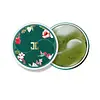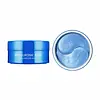What's inside
What's inside
 Key Ingredients
Key Ingredients

 Benefits
Benefits

 Concerns
Concerns

 Ingredients Side-by-side
Ingredients Side-by-side

Water
Skin ConditioningGlycerin
HumectantButylene Glycol
HumectantNiacinamide
SmoothingChondrus Crispus
MaskingPotassium Chloride
Tripropylene Glycol
AntioxidantDipropylene Glycol
HumectantBetaine
HumectantSodium Hyaluronate
HumectantPaeonia Lactiflora Root Extract
Skin ConditioningGlycyrrhiza Glabra Root Extract
BleachingPolygonum Multiflorum Root Extract
Skin ConditioningPhellinus Linteus Extract
Skin ConditioningMorus Alba Bark Extract
Skin ConditioningSophora Angustifolia Root Extract
Skin ConditioningCimicifuga Racemosa Root Extract
AntimicrobialSesamum Indicum Seed Extract
Skin ConditioningScutellaria Baicalensis Root Extract
AstringentAngelica Gigas Root Extract
Skin ConditioningPentylene Glycol
Skin ConditioningCocos Nucifera Fruit Extract
EmollientPinus Sylvestris Leaf Extract
TonicCamellia Sinensis Leaf Powder 0.2%
ExfoliatingSaururus Chinensis Extract
Skin ConditioningCeratonia Siliqua Gum
EmollientSucrose
HumectantIsopropyl Alcohol
SolventCalcium Chloride
AstringentCyamopsis Tetragonoloba Gum
Emulsion StabilisingCellulose Gum
Emulsion StabilisingChondrus Crispus Powder
AbrasiveAllantoin
Skin ConditioningAdenosine
Skin ConditioningDisodium EDTA
Calcium Lactate
AstringentEthyl Hexanediol
Solvent1,2-Hexanediol
Skin ConditioningPropanediol
SolventCaprylyl Glycol
EmollientEthylhexylglycerin
Skin ConditioningCI 77288
Cosmetic ColorantPolyglyceryl-10 Laurate
Skin ConditioningParfum
MaskingChlorphenesin
AntimicrobialWater, Glycerin, Butylene Glycol, Niacinamide, Chondrus Crispus, Potassium Chloride, Tripropylene Glycol, Dipropylene Glycol, Betaine, Sodium Hyaluronate, Paeonia Lactiflora Root Extract, Glycyrrhiza Glabra Root Extract, Polygonum Multiflorum Root Extract, Phellinus Linteus Extract, Morus Alba Bark Extract, Sophora Angustifolia Root Extract, Cimicifuga Racemosa Root Extract, Sesamum Indicum Seed Extract, Scutellaria Baicalensis Root Extract, Angelica Gigas Root Extract, Pentylene Glycol, Cocos Nucifera Fruit Extract, Pinus Sylvestris Leaf Extract, Camellia Sinensis Leaf Powder 0.2%, Saururus Chinensis Extract, Ceratonia Siliqua Gum, Sucrose, Isopropyl Alcohol, Calcium Chloride, Cyamopsis Tetragonoloba Gum, Cellulose Gum, Chondrus Crispus Powder, Allantoin, Adenosine, Disodium EDTA, Calcium Lactate, Ethyl Hexanediol, 1,2-Hexanediol, Propanediol, Caprylyl Glycol, Ethylhexylglycerin, CI 77288, Polyglyceryl-10 Laurate, Parfum, Chlorphenesin
Water
Skin ConditioningGlycerin
HumectantDipropylene Glycol
HumectantChondrus Crispus
MaskingCeratonia Siliqua Gum
EmollientButylene Glycol
HumectantGlucose
HumectantSodium Hyaluronate
HumectantPotassium Chloride
Pearl Powder
Hydroxyethylcellulose
Emulsion StabilisingCollagen
MoisturisingCyamopsis Tetragonoloba Gum
Emulsion StabilisingEthylhexylglycerin
Skin ConditioningDisodium EDTA
Parfum
MaskingCitrus Unshiu Peel Extract
MaskingAloe Barbadensis Leaf Extract
EmollientCamellia Sinensis Leaf Extract
AntimicrobialAlgae Extract
EmollientRose Extract
Skin ConditioningAnthemis Nobilis Flower Extract
MaskingPunica Granatum Fruit Extract
AntioxidantMelaleuca Alternifolia Leaf Water
AntimicrobialEucalyptus Globulus Leaf Extract
PerfumingGlycine Soja Phytoplacenta Extract
Skin ConditioningCI 77499
Cosmetic ColorantWater, Glycerin, Dipropylene Glycol, Chondrus Crispus, Ceratonia Siliqua Gum, Butylene Glycol, Glucose, Sodium Hyaluronate, Potassium Chloride, Pearl Powder, Hydroxyethylcellulose, Collagen, Cyamopsis Tetragonoloba Gum, Ethylhexylglycerin, Disodium EDTA, Parfum, Citrus Unshiu Peel Extract, Aloe Barbadensis Leaf Extract, Camellia Sinensis Leaf Extract, Algae Extract, Rose Extract, Anthemis Nobilis Flower Extract, Punica Granatum Fruit Extract, Melaleuca Alternifolia Leaf Water, Eucalyptus Globulus Leaf Extract, Glycine Soja Phytoplacenta Extract, CI 77499
 Reviews
Reviews

Ingredients Explained
These ingredients are found in both products.
Ingredients higher up in an ingredient list are typically present in a larger amount.
Butylene Glycol (or BG) is used within cosmetic products for a few different reasons:
Overall, Butylene Glycol is a safe and well-rounded ingredient that works well with other ingredients.
Though this ingredient works well with most skin types, some people with sensitive skin may experience a reaction such as allergic rashes, closed comedones, or itchiness.
Learn more about Butylene GlycolCeratonia Siliqua Gum is extracted from the seeds of the carob tree. You might know this ingredient as Carob Gum or Locust Bean Gum. It is used to stabilize other ingredients and improve the texture of products.
Carob gum is made up of long-chain polysaccharides. This makes it a natural thickener.
Yes! This ingredient comes from the seeds of a tree. The name 'Locust Bean Gum' can be misleading.
Learn more about Ceratonia Siliqua GumChondrus Crispus is a red algae native to the northern Atlantic ocean.
It is rich in antioxidants. The polysaccharides, peptides, and amino acid content helps moisturize skin.
Antioxidants present in chondrus crispus include lutein and zeaxanthin. Lutein has the ability to filter blue light from screens.
Learn more about Chondrus CrispusGuar gum is made from the guar bean, a plant native to India. It is considered a form of polysaccharide and naturally contains sugar.
This ingredient is often used to thicken a product or create a gel-like consistency.
It also has emulsion properties to help keep ingredients together.
Learn more about Cyamopsis Tetragonoloba GumDipropylene Glycol is a synthetically created humectant, stabilizer, and solvent.
This ingredient helps:
Dipropylene glycol is technically an alcohol, but it belongs to the glycol family (often considered part of the ‘good’ alcohols). This means it is hydrating and gentle on skin unlike drying solvent alcohols like denatured alcohol.
As a masking agent, Dipropylene Glycol can be used to cover the smell of other ingredients. However, it does not have a scent.
Studies show Dipropylene Glycol is considered safe to use in skincare.
Learn more about Dipropylene GlycolDisodium EDTA plays a role in making products more stable by aiding other preservatives.
It is a chelating agent, meaning it neutralizes metal ions that may be found in a product.
Disodium EDTA is a salt of edetic acid and is found to be safe in cosmetic ingredients.
Learn more about Disodium EDTAEthylhexylglycerin (we can't pronounce this either) is commonly used as a preservative and skin softener. It is derived from glyceryl.
You might see Ethylhexylglycerin often paired with other preservatives such as phenoxyethanol. Ethylhexylglycerin has been found to increase the effectiveness of these other preservatives.
Glycerin is already naturally found in your skin. It helps moisturize and protect your skin.
A study from 2016 found glycerin to be more effective as a humectant than AHAs and hyaluronic acid.
As a humectant, it helps the skin stay hydrated by pulling moisture to your skin. The low molecular weight of glycerin allows it to pull moisture into the deeper layers of your skin.
Hydrated skin improves your skin barrier; Your skin barrier helps protect against irritants and bacteria.
Glycerin has also been found to have antimicrobial and antiviral properties. Due to these properties, glycerin is often used in wound and burn treatments.
In cosmetics, glycerin is usually derived from plants such as soybean or palm. However, it can also be sourced from animals, such as tallow or animal fat.
This ingredient is organic, colorless, odorless, and non-toxic.
Glycerin is the name for this ingredient in American English. British English uses Glycerol/Glycerine.
Learn more about GlycerinParfum is a catch-all term for an ingredient or more that is used to give a scent to products.
Also called "fragrance", this ingredient can be a blend of hundreds of chemicals or plant oils. This means every product with "fragrance" or "parfum" in the ingredients list is a different mixture.
For instance, Habanolide is a proprietary trade name for a specific aroma chemical. When used as a fragrance ingredient in cosmetics, most aroma chemicals fall under the broad labeling category of “FRAGRANCE” or “PARFUM” according to EU and US regulations.
The term 'parfum' or 'fragrance' is not regulated in many countries. In many cases, it is up to the brand to define this term.
For instance, many brands choose to label themselves as "fragrance-free" because they are not using synthetic fragrances. However, their products may still contain ingredients such as essential oils that are considered a fragrance by INCI standards.
One example is Calendula flower extract. Calendula is an essential oil that still imparts a scent or 'fragrance'.
Depending on the blend, the ingredients in the mixture can cause allergies and sensitivities on the skin. Some ingredients that are known EU allergens include linalool and citronellol.
Parfum can also be used to mask or cover an unpleasant scent.
The bottom line is: not all fragrances/parfum/ingredients are created equally. If you are worried about fragrances, we recommend taking a closer look at an ingredient. And of course, we always recommend speaking with a professional.
Learn more about ParfumPotassium Chloride can be bad for oily skin and be bad for acne prone skin.
Sodium Hyaluronate is hyaluronic acid's salt form. It is commonly derived from the sodium salt of hyaluronic acid.
Like hyaluronic acid, it is great at holding water and acts as a humectant. This makes it a great skin hydrating ingredient.
Sodium Hyaluronate is naturally occurring in our bodies and is mostly found in eye fluid and joints.
These are some other common types of Hyaluronic Acid:
Learn more about Sodium HyaluronateWater. It's the most common cosmetic ingredient of all. You'll usually see it at the top of ingredient lists, meaning that it makes up the largest part of the product.
So why is it so popular? Water most often acts as a solvent - this means that it helps dissolve other ingredients into the formulation.
You'll also recognize water as that liquid we all need to stay alive. If you see this, drink a glass of water. Stay hydrated!
Learn more about Water